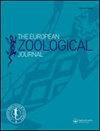Redescriptions of Dussumieria elopsoides Bleeker, 1849 and related nominal species led to the revalidation of Dussumieria hasseltii Bleeker, 1851 and Dussumieria productissima Chabanaud, 1933 (Clupeiformes: Dussumieriidae)
IF 1.6
4区 生物学
Q2 ZOOLOGY
引用次数: 1
Abstract
Abstract Numerous rainbow sardine specimens, previously identified as Dussumieria elopsoides Bleeker, 1849, due to their elongate body, scales without posterior striae, and numerous gill rakers and branchiostegal rays, were examined and confirmed as representing four valid species: true D. elopsoides (restricted to Indonesia), Dussumieria hasseltii Bleeker, 1851 (previously regarded as a junior synonym of D. elopsoides; Arabian Sea to Philippines and Indonesia), Dussumieria modakandai Singh, Jayakumar, Kumar, Murali, Mishra, Singh and Lal, 2021 (Arabian Sea to Ryukyu Islands), and Dussumieria productissima Chabanaud, 1933 (previously regarded as a junior synonym of D. elopsoides; Gulf of Aden, Red Sea and eastern Mediterranean). Each species is redescribed in detail and a key based on morphological characters provided. The phylogenetic relationships among seven species of Dussumieria (including three of the species examined in the present study) were reconstructed from the cytochrome oxidase I (COI) gene, the genetic distinctiveness of each species being indicated by at least 4.1% mean p-distance divergence from the others.1849年,对欧洲杜父菌(Dusumieria elopsoides Bleeker)和相关标称物种的重新描述导致了1851年和1933年杜父菌生产型杜父菌Chabanaud(Clupeiformes:杜父菌科)的重新验证
摘要许多彩虹沙丁鱼标本,由于其细长的身体、没有后纹的鳞片以及大量的鳃耙和鳃盖射线,在1849年被鉴定为Dusumieria elopsoides Bleeker,被检查并证实代表了四个有效的物种:真正的D.elopsoide斯(仅限于印度尼西亚)、Dusumiera hasseltii Bleeker,1851年(以前被认为是D.elopsoides的初级同义词;阿拉伯海到菲律宾和印度尼西亚),Dusumieria modakandai Singh,Jayakumar,Kumar,Murali,Mishra,Singh和Lal,2021年(阿拉伯海到琉球群岛),以及Dusumiera productissima Chabanaud,1933年(之前被认为是D.elopsoide斯的初级同义语;亚丁湾、红海和东地中海)。每个物种都被详细地重新描述,并根据形态学特征提供了一个密钥。从细胞色素氧化酶I(COI)基因重建了七个Dusumieria物种(包括本研究中检测的三个物种)之间的系统发育关系,每个物种与其他物种的遗传差异至少为4.1%的平均p距离差异。
本文章由计算机程序翻译,如有差异,请以英文原文为准。
求助全文
约1分钟内获得全文
求助全文
来源期刊

European Zoological Journal
Agricultural and Biological Sciences-Animal Science and Zoology
CiteScore
3.10
自引率
5.60%
发文量
80
审稿时长
30 weeks
期刊介绍:
The European Zoological Journal (previously Italian Journal of Zoology) is an open access journal devoted to the study of all aspects of basic, comparative and applied protozoan and animal biology at molecular, cellular, tissue, organ, organismal, population, and community-ecosystem level. Papers covering multiple levels of organization and integrative approaches to study animal form, function, development, ecology, evolution and systematics are welcome. First established in 1930 under the name of Il Bollettino di Zoologia, the journal now has an international focus, reflected through its global editorial board, and wide author and readership.
 求助内容:
求助内容: 应助结果提醒方式:
应助结果提醒方式:


